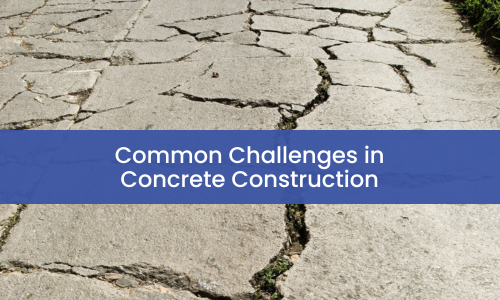Common challenges contractors face in concrete construction projects include:
- Cracking
- Crazing and other surface-level defects
- Spalling
- Soil instability and settlement
- Poor construction practices
Concrete is characterized by its durability and is one of construction’s most reliable materials. However, it is also prone to certain issues if it’s not installed and maintained properly.
Common Causes of Concrete Construction Problems
If your concrete is showing signs of wear or other problems, there could be a number of factors involved. Here are some of the most common issues and what causes these concrete problems:
- Cracking – Concrete inevitably cracks. In general, minor cracks will not threaten the pavement’s structural stability or its function, but they can expose subsurface layers (and the aggregates contained in them) to potential water damage.
Avoiding cracking is one of the toughest challenges in concrete construction because it can be caused by many things. Cracks may form in concrete if it’s not poured or cured properly – if the concrete is allowed to dry too quickly, for example. Cracking may also occur if the subgrade – the soil under the concrete pavement – isn’t stabilized before construction. Shifting subgrades are a primary cause of major cracking.
Cracks may also be the result of impact damage, water damage, certain weather patterns, or overloading.
When concrete contractors inspect cracks prior to repairs, they are looking for a couple of things: How wide (and widespread) are the cracks, and are the cracks “working?” Working cracks are those that are still actively spreading. These are at a greater risk of worsening over time.
If cracks are thin enough and aren’t spreading, they can be reliably addressed with a concrete crack sealer, and routing and filling is a proven approach in this regard. For working cracks or larger cracks, concrete contractors may recommend epoxy injections or – in the case of extensive or structural cracks – stitching. In general, though, widespread major cracking is best addressed by removing any failed concrete, resolving the underlying problem and installing new concrete.
- Crazing and other surface-level defects – Deep, working cracks typically require full pavement replacement, but superficial issues like crazing (surface hairline cracks), blistering, delamination and minor popouts typically do not require comprehensive repairs.
If the concrete’s problems are not caused by an ongoing factor like unstable soil, a thin concrete overlay may be sufficient to address surface defects. Overlaying concrete is difficult and only recommended in certain situations, but it can be appropriate for minor concrete issues like these.
- Spalling and large popouts – When extensive spalling or large popouts affect concrete pavement, it is often due to poor curing techniques, poor quality concrete mix, or exposure to extreme weather conditions.
Isolated spalls and popouts may be addressed by patching and filling, but if they are extensive or deep enough to cause issues with motorist or pedestrian safety, it’s likely time to replace the pavement.
- Soil instability and settlement – The hallmark of most low quality, rushed concrete jobs is a lack of subgrade preparation. Unstable soils are found everywhere and must be accounted for before installing concrete. This includes analyzing the soil’s composition, stabilizing it with additives (when needed) and compacting it to depth. When this process is not fully observed, it is only a matter of time before the underlying subgrade shifts and causes pavement problems.
One sign of unstable soil is pooling water. If water is gathering in spots, your concrete may be developing depressions – and these will eventually become potholes. Another sign of unstable soil is large fractures. Major fractures may result from movement under the concrete slab, as the tensile forces are too much for concrete to typically overcome.
The only repair that can restore fractured concrete is total pavement replacement.
- Poor construction and installation techniques – Rushed or poorly executed installation methods will lead to ongoing problems with your concrete. If the concrete is not formed correctly, cracks and spalls will follow. If the project site is not properly prepared, the concrete will be stressed by unstable soil. If a poor-quality concrete mix is used, delamination and aggregate loss will occur. If the concrete is not properly cured, shrinkage and cracks will form. If air is not vibrated out of the concrete, popout and “bugholes” may emerge. If drainage structures are not properly positioned and installed, water will back up on the property and cause ongoing issues.
Avoid Common Challenges in Concrete Construction with a Proven Concrete Contractor
Some concrete issues cannot be avoided, such as minor cracking over time. However, many problems are completely preventable if you are working with an experienced, reputable concrete contractor. As many concrete problems are the result of poor materials or workmanship, partnering with a reputable concrete contractor will protect your organization from those shoddy work practices.
Look for a concrete contractor with a history of projects similar to yours. They should be willing to provide contacts for previous clients so you can verify the contractor’s work quality.
A reputable paving company will protect your property from many common concrete problems, and they can provide ongoing maintenance as well, which will prevent wear and tear from ruining your concrete early.
- HOA & Condos – How Asphalt Pavement Can Affect Your Houston Property Values - March 6, 2025
- What Certifications or Licenses Should a Houston Asphalt Contractor Have? - September 17, 2024
- Common Challenges in Concrete Construction - September 11, 2024

